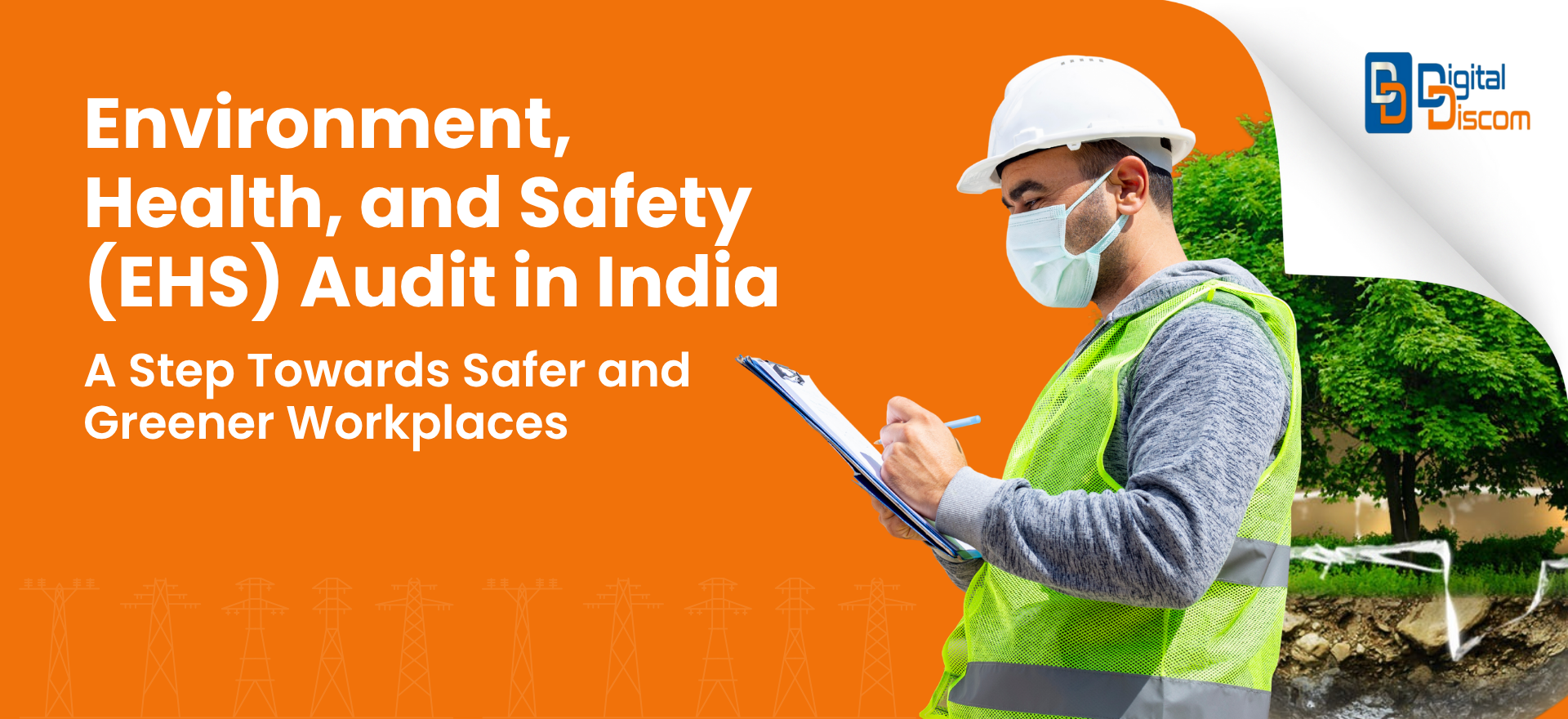Scope, Advantages, Process, and Applicability for Businesses
1. What is an EHS Audit?
An EHS Audit refers to a systematic, documented, and objective evaluation of an organization’s adherence to environmental, health, and Safety regulations, internal policies, and best practices. It helps identify non-compliance, operational risks, and opportunities for improvement related to environmental sustainability, occupational health, and worker safety.
Key Objectives
- Assess compliance with Indian statutory laws (Factories Act, 1948; Environment Protection Act, 1986; Occupational Safety Codes).
- Evaluate alignment with ISO standards like:
- ISO 14001:2015 (Environmental Management System)
- ISO 45001:2018 (Occupational Health & Safety Management System)
- Minimize risk of accidents, environmental liabilities, and legal penalties.
- Promote sustainable operations and improve corporate ESG ratings.
2. Scope of EHS Audits
Environmental Compliance
- Air & Water Pollution: Stack emissions, effluent discharge compliance.
- Hazardous Waste Management: Proper disposal as per Hazardous Waste Rules.
- Noise & Vibration Monitoring.
- Energy & Resource Optimization.
Health Compliance
- Occupational Health Monitoring: Regular health check-ups for workers exposed to hazardous environments.
- Industrial Hygiene: Indoor air quality, dust, and fume exposure monitoring.
Safety Compliance
- Risk Assessment: Identification of unsafe practices and hazard-prone zones.
- Fire Safety & Emergency Preparedness: Fire drills, evacuation plans.
- Workplace Safety Training: PPE compliance, signage adequacy.
3. Advantages of EHS Audit
- Regulatory Compliance
Avoid penalties under Indian labor and environmental laws, and stay compliant with CPCB, SPCB, and MoEFCC guidelines. - Risk Mitigation
Identify and eliminate workplace hazards, reducing incidents of industrial accidents, fire hazards, and occupational diseases. - Cost Savings
Prevent litigation costs, insurance claims, and downtime losses by proactive safety management. - Sustainability & ESG Performance
Enhance environmental stewardship and strengthen sustainability reporting for CSR compliance and global investors. - Improved Productivity & Employee Morale
A safe work environment leads to higher employee retention and efficiency.
4. Applicability: Who Needs an EHS Audit?
EHS audits are mandatory or highly recommended for:
- Manufacturing Industries (Steel, Cement, Textile, FMCG, Chemicals).
- Pharmaceutical Plants – For compliance with GMP & FDA norms.
- Oil & Gas Refineries – High-risk category.
- Mining & Mineral Processing Units.
- Power Plants & Utilities (Thermal, Nuclear, and Renewable Energy).
- Construction & Infrastructure Projects.
- Data Centers & IT Parks – For fire safety, electrical safety, and ergonomics.
- Warehouses & Logistics Hubs.
5. Regulatory & Legal Framework in India
EHS audits help organizations comply with:
- Factories Act, 1948
- Environment Protection Act, 1986
- Air Act, 1981 & Water Act, 1974
- Hazardous Waste (Management & Handling) Rules, 1989
- Building and Other Construction Workers Act, 1996
- Indian Boilers Act, 1923
- ISO 14001 & ISO 45001 standards
6. Process of EHS Audit
Step 1: Pre-Audit Planning
- Define audit scope (entire facility or specific processes).
- Review past compliance reports and incident history.
Step 2: Documentation Review
- Examine licenses, permits, safety manuals, and SOPs.
- Verify compliance with state pollution control board norms.
Step 3: On-Site Inspection
- Visual Assessment: Hazard identification, safety signage, housekeeping.
- Measurement & Testing:
- Air emission & stack monitoring.
- Noise & vibration analysis.
- Water & effluent quality testing.
Step 4: Employee Interaction
- Interview workers and EHS officers on safety practices and incident handling.
Step 5: Gap Analysis
- Benchmark against statutory requirements and ISO standards.
- Identify non-compliance and risk-prone areas.
Step 6: Corrective Action Plan
- Detailed report with risk ratings, CAPEX/OPEX estimates, and recommendations.
Step 7: Follow-up & Verification
- Post-implementation audit to verify closure of gaps.
7. EHS Audit Tools & Techniques
- Hazard Identification & Risk Assessment (HIRA)
- Job Safety Analysis (JSA)
- Behavior-Based Safety (BBS) Audits
- Root Cause Analysis (RCA) for past incidents.
- Energy & Environmental Monitoring Equipment (Gas detectors, dust monitors, stack emission analyzers).
8. Leading EHS Audit Service Providers in India
- TÜV SÜD South Asia
- Bureau Veritas India
- DNV GL
- SGS India Pvt. Ltd.
- Intertek India
- UL India Pvt. Ltd.
- ERM (Environmental Resources Management)
- Local EHS Consultants certified by NABCB & QCI
9. EHS Audit Frequency & Cost
- Frequency: Typically annual audits or more frequent for high-risk industries.
- Cost Factors:
- Facility size and complexity.
- Number of locations audited.
- Type of audit (basic compliance vs. ISO certification audit).
Indicative Costs:
- Small Units (Single Facility): ₹50,000 – ₹1,50,000.
- Medium Enterprises: ₹2,00,000 – ₹5,00,000.
- Large Industrial Complexes: ₹5,00,000 – ₹15,00,000+.
10. How UrjaOne Platform Can Help Businesses with EHS Audits
UrjaOne, India’s Energy and Compliance Services Marketplace, makes EHS audits hassle-free by:
✔ Connecting Businesses with Certified EHS Audit Firms across India.
✔ Comparing Multiple Quotes for cost-effective services.
✔ Providing Integrated Services – Energy Audits + EHS Audits for holistic sustainability.
✔ Digital Document Management for compliance records.
✔ Guidance on ISO Certification, Environmental Reporting, and Legal Compliance.
With UrjaOne, organizations can ensure legal compliance, reduce risk exposure, and improve ESG performance effortlessly.
Conclusion
An EHS Audit is not just a compliance requirement; it is a strategic investment in risk mitigation, sustainability, and business continuity. From pollution control and workplace safety to ISO certification readiness, EHS audits help companies align with national regulations and global best practices.
UrjaOne simplifies this journey by connecting businesses with certified EHS auditors, ensuring timely compliance and safer workplaces.




